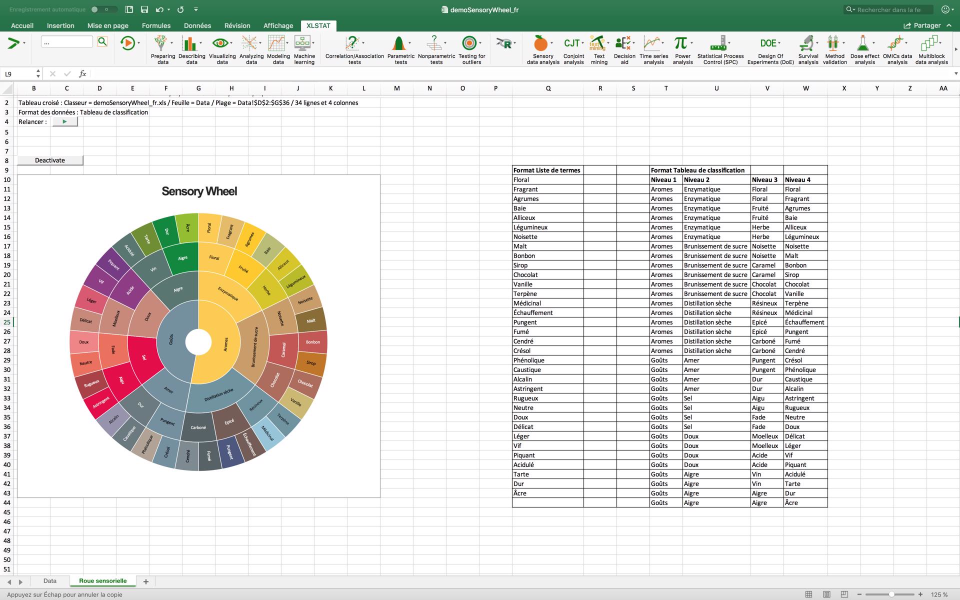
This corresponds to 3591 data points (3 experimental treatments x 35 volatiles x 3 replicates = 315 data points 3 experimental treatments x 9 sensory attributes x 121 consumer panelists = 3267 data points) for each meat type, or 7164 data points for beef and moose merged data. A data set consisting of a total of 35 volatiles (23 terpenes and 12 thiol compounds) and 9 consumer sensory attributes in each sample are considered in this study. The consumer evaluation of the sweetness, saltiness, sourness, spiciness, aftertaste, tenderness, overall flavor, overall aroma, and overall preference of the unmarinated and marinated grilled meat samples was also performed. The volatile metabolites present in the headspace of the unmarinated and marinated grilled ruminant meats were identified and subsequently semi-quantified based on the area counts × 10 −6 of the base peak. The aim of this MethodsX paper is to present a detailed step-by-step data analysis approach to demonstrate the use of principal component analysis to summarize, visualize and interpret the volatile metabolites and sensory attributes of marinated and unmarinated grilled ruminant meat using XLSTAT as the platform.
#XLSTAT SOFTWARE SOFTWARE#
XLSTAT is a statistical software that can be employed to perform multivariate analysis of complex data sets. Principal component analysis (PCA) is a multivariate statistical technique applied to reduce the number of variables (i.e., volatile metabolites) into a few uncorrelated variables named principal components (or factors) based on patterns of correlation of the original variables. The volatile profile and sensory test analyses of the grilled meat were complex data sets (more than 100 volatile compounds were identified, and 9 sensory attributes were scored in each sample) requiring the use of multivariate statistics for their analysis. In a previous study, moose and beef steaks were marinated with two novel formulations of unfiltered beer-based marinades, and grilled. This process adds new compounds, which could have antioxidant properties and flavours, improving the sensory characteristics and preserving the meat nutritional quality. Meat marination is the process of incubating the meat into a seasoned liquid base before cooking. The nutritional and sensory quality (e.g., appearance, texture, aroma, and flavor) are 2 key factors which determine consumers meat choice. Meat is an excellent source of nutrients including proteins, dietary fatty acids, essential minerals, and vitamins.

XLSTAT statistical and data analysis solution. “Novel unfiltered beer-based marinades to improve the nutritional quality, safety, and sensory perception of grilled ruminant meats” Food chemistry 302 (2020): 125326.


Results indicated that final body weight was significantly (P 0.The use of XLSTAT in conducting principal component analysis (PCA) when evaluating the relationships between sensory and quality attributes in grilled foods Sixteen Karadi male lambs weighing 23.29 ± 0.42 kg and 4.5-5 months old randomly divided into equally four treatment groups and individually penned for the period of 63 days. Pomegranate Peel, Growth Performance, Digestibility, Karadi LambsĪBSTRACT: The objective of current study was to determine the effect of different ratios of pomegranate peel in diets of Karadi lambs (0%, 1%, 2% or 4% as control, T1, T2 and T3, respectively) on body weight, total body gain, average daily gain, daily feed intake and apparent digestibility of nutrients. Growth Performance and Digestibility in Karadi Lambs Receiving Different Levels of Pomegranate PeelsĪUTHORS: Sarwar M. XLSTAT (2007) Statistical Software for Excel.


 0 kommentar(er)
0 kommentar(er)
